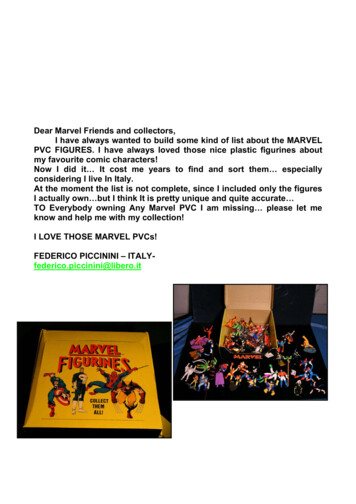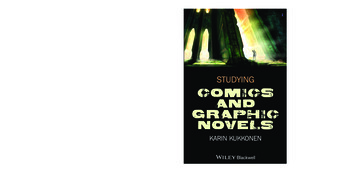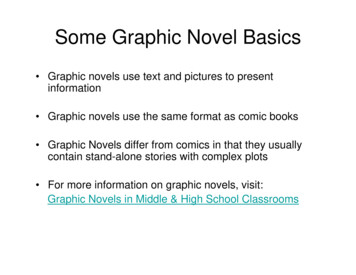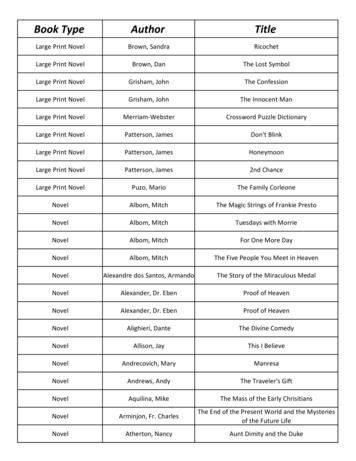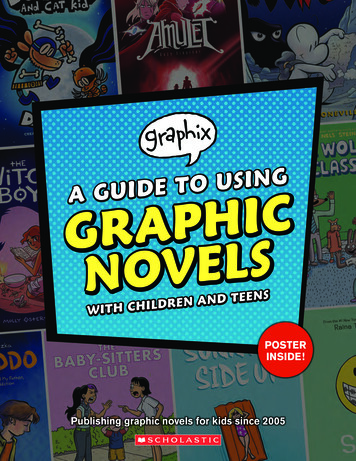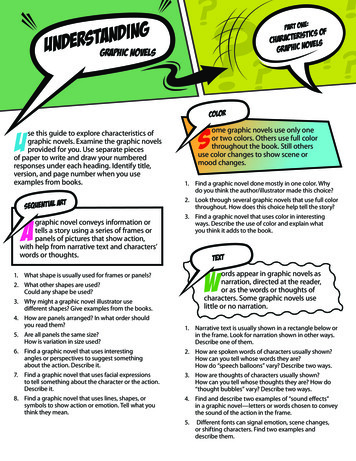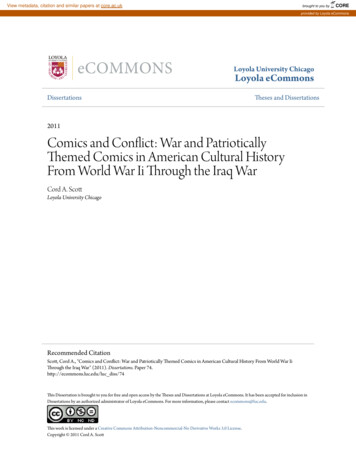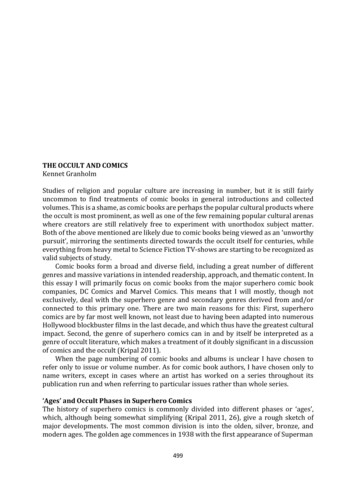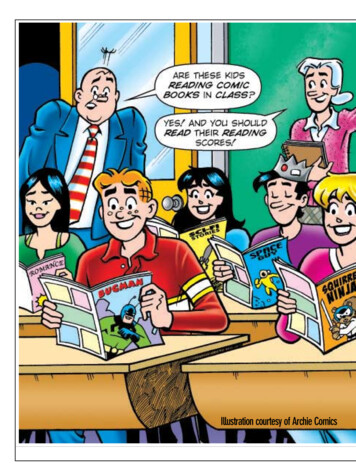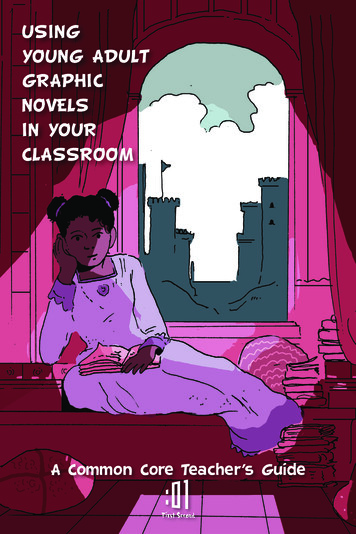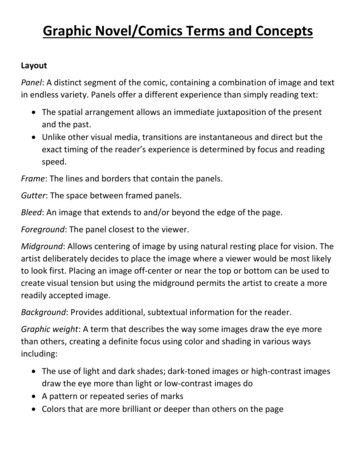
Transcription
Graphic Novel/Comics Terms and -1102.htmlLayoutPanel: A distinct segment of the comic, containing a combination of image and textin endless variety. Panels offer a different experience than simply reading text:The spatial arrangement allows an immediate juxtaposition of the presentand the past.Unlike other visual media, transitions are instantaneous and direct but theexact timing of the reader’s experience is determined by focus and readingspeed.Frame: The lines and borders that contain the panels.Gutter: The space between framed panels.Bleed: An image that extends to and/or beyond the edge of the page.Foreground: The panel closest to the viewer.Midground: Allows centering of image by using natural resting place for vision. Theartist deliberately decides to place the image where a viewer would be most likelyto look first. Placing an image off-center or near the top or bottom can be used tocreate visual tension but using the midground permits the artist to create a morereadily accepted image.Background: Provides additional, subtextual information for the reader.Graphic weight: A term that describes the way some images draw the eye morethan others, creating a definite focus using color and shading in various waysincluding:The use of light and dark shades; dark-toned images or high-contrast imagesdraw the eye more than light or low-contrast images doA pattern or repeated series of marksColors that are more brilliant or deeper than others on the page
Graphic Novel/Comics Terms and -1102.htmlFiguresFaces: Faces can be portrayed in different ways. Some depict an actual person, likea portrait; others are iconic, which means they are representative of an idea or agroup of people. Other points to observe about faces include:They can be dramatic when placed against a detailed backdrop; a brightwhite face stands out.They can be drawn without much expression or detail; this is called an “openblank” and it invites the audience to imagine what the character is feelingwithout telling them.Hands/Feet: The positioning of hands and feet can be used to express what ishappening in the story. For example, hands that are raised with palms out suggestsurprise. The wringing of hands suggests obsequiousness or discomfort. Handsover the mouth depict fear, shame, or shyness. Turned in feet may denoteembarrassment, while feet with motion strokes can create the sense of panic,urgency, or speed.TextCaptions: These are boxes containing a variety of text elements, including scenesetting, description, etc.Speech balloons: These enclose dialogue and come from a specific speaker’smouth; they vary in size, shape, and layout and can alternate to depict aconversation. Types of speech balloons include those holding:External dialogue, which is speech between charactersInternal dialogue, which is a thought enclosed by a balloon that has a seriesof dots or bubbles going up to itSpecial-effects lettering: This is a method of drawing attention to text; it oftenhighlights onomatopoeia and reinforces the impact of words such as bang or wow.
!!!!Graphic novel!!voice e!!!!!!!iconpanel!! Marjane Satrapi, 2000gutter!!!!!!!!! Brad Philpot, InThinkingwww.englishalanglit-inthinking.co.uk1!
!!!!Definitions of featuresPanel – Panel refers to the framed image. It offers the reader a perspective or pointof view on the subjects also known as the camera angle. Sometimes panels do nothave borders, creating a unique effect where the subject seems to stand outside thestoryline.Splash – Splash is a kind of panel that spans the width of the page. If it runs off thepage entirely, it is known as a ‘bleed’.Voice over – Narrators have the possibility to speak directly to the reader through avoice over. Usually this is done with a hard line separating the narrator’s speech atthe top or bottom of a panel from the image within the panel.Speech bubble – These are frames around the characters’ language, a kind of‘direct speech’, where the characters speak for themselves. If these appear asclouds, they represent the character’s thoughts. If they appear in jagged lines, thecharacter is shouting.Emanata – This term refers to the teardrops, sweat drops, question marks, or motionlines that artists draw besides characters’ faces to portray emotion.Gutter – This refers to the space between panels. Readers tend to ‘fill in the blanks’and imagine what happens between panels, a process known as ‘closure’.More aspects to considerStyle - The artist’s drawing style can be discussed using several terms. ScottMcCloud, in Understanding Comics, shows that there are four ‘scales’ of style:complex to simple, realistic to iconic, objective to subjective, specific to universal.Colour – The colours that an authoruses will affect the reader’sexperience as well.Narration – Keep in mind that comicbooks allow the writer to show and tellat the same time, meaning there canbe a combination of direct narrationand indirect narration. Scott McCloud, 1993!!!! Brad Philpot, InThinkingwww.englishalanglit-inthinking.co.uk2!
!!!!Time – Graphic novels and comic books do not have to tell a story in a linear way.Besides the use of transitions between panels artists can explore multiple momentsin one panel, like a collage. Marjane Satrapi, 2000Graphic weight – This term is used to discuss the amount of contrast in an image.Are blacks offset with whites? Are there many shades of grey in between? Withregards to colour images, one can look for the degree to which colours are vivid oropaque.Foreground – Where is the subject or the point of focus for the reader. If the subjectseems closer to the reader, in the front of the scene depicted, it stands in the‘foreground’.Midground – If the subject stands in the middle of the scene that is depicted, thernthere it is in the midground. Placing a subject off-centre can also be used to createvisual tension.Background – The objects in the background (not usually the subject) help addcontextual information for the reader.Camera angle – If the panel were a photograph, where would the camera stand inrelation to its subject? How far away from the subject is the camera? Is it a long shot,medium shot or close up? At what angle is the camera pitched? Is it a bird’s eyeview, a high angle, eye-level, or low angle? All of this will have an effect on thereader’s understanding of the subject.!!!! Brad Philpot, InThinkingwww.englishalanglit-inthinking.co.uk3!
!!!!Transitions - There are six types of transitions that artists use in comic books, all ofwhich have a different effect on the reader. Transitions refer to the process ofclosure (where the reader mentally ‘fills in the gaps’) in the gutter, between panels.1. Moment to moment2. Action to action3. Subject to subject4. Scene to scene5. Aspect to aspect6. Non-sequitur Scott McCloud, 1993!!!! Brad Philpot, InThinkingwww.englishalanglit-inthinking.co.uk4!
!!!!Test your understandingApply the terminology that you have learned to the following page from Persepolis byMarjane Satrapi. Give a detailed analysis of the stylistic and structural features thatshe uses. Explain their effects on the target audience? Why has she made theseartistic choices?!!!! Brad Philpot, InThinkingwww.englishalanglit-inthinking.co.uk5!
Transitions - There are six types of transitions that artists use in comic books, all of which have a different effect on the reader. Transitions refer to the process of closure (where the reader mentally ‘fills in the gaps’) in the gutter, between panels. 1. Moment to moment 2. Ac

